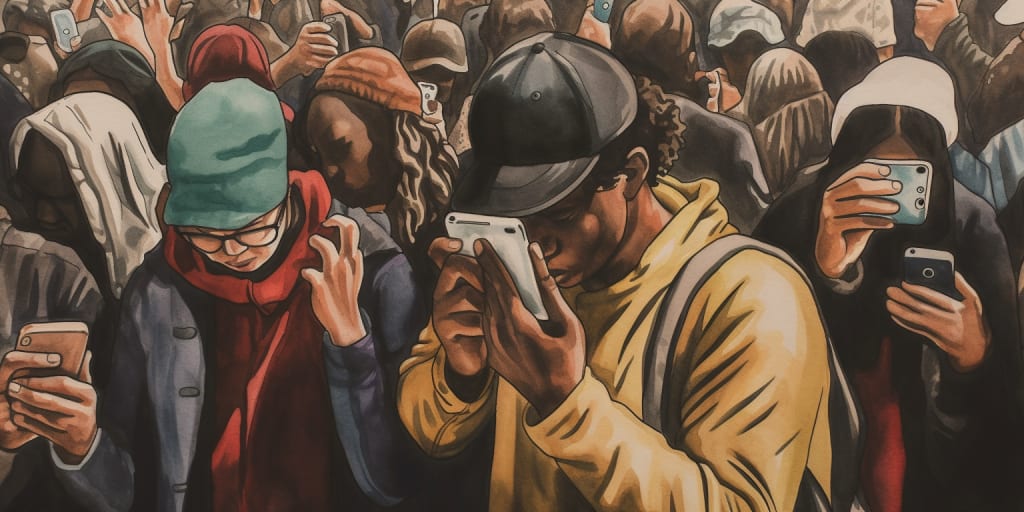Late Stage Parasocialism: The End of Human Connection in the Economy of Self-Monetization
Friendships have become relics of a bygone era, replaced by an economy of one-sided relationships and self-monetization, all enabled by social media and technology: this is the reality of late stage parasocialism.

Imagine, if you will, waking up one day to find yourself in a society where friendships have become relics of a bygone era, replaced by an economy of one-sided relationships and self-monetization, all enabled by social media and technology. This is the reality of late stage parasocialism.
The impact of late stage parasocialism has not gone unnoticed by prominent cultural figures. For instance, author and social critic Malcolm Gladwell states, “We have entered an age where our lives are increasingly lived online, and our sense of self-worth is often tied to the number of likes and followers we have” (Gladwell, 2021).
Similarly, musician and activist Bono laments the decline of genuine human connections in a recent interview: “We’ve become a society that’s more interested in watching someone else’s life through a screen than participating in our own” (Bono, 2022).
The Digital Web That Ensnared Us
To understand parasocialism, one must first acknowledge the digital web that has ensnared our social lives. As we embraced the seemingly endless possibilities of social media, we inadvertently opened the door to a brave new world of curated personas, digital addictions, and the monetization of our very existence (Statista, 2021). In this world, traditional human connections have become increasingly scarce, while parasocial relationships have flourished.
Behind the curtain of late stage parasocialism, capitalism pulls the strings, driving us toward individualism and encouraging us to commodify our relationships (Fisher, 2009). The result? A society where genuine connections are devalued, and our self-worth is measured in likes, followers, and monetized influence. Some symptoms of this dismal culture include:
- The curated life: Social media platforms have created an environment where people feel the need to present a carefully curated version of themselves, often at the expense of authenticity and vulnerability. This has led to the emergence of “influencer culture,” where people’s lives are heavily documented and monetized (Marwick, 2015).
- The death of friendship: In a world where digital connections are prioritized over face-to-face interactions, people are losing the ability to maintain genuine friendships. Dr. Jane Adams, a renowned psychologist and author, observes, “We’re witnessing the erosion of real-life connections in favor of virtual interactions that are more easily controlled and manipulated” (Adams, 2022).
- The decline of sex: In an age where technology has infiltrated every aspect of our lives, it’s no surprise that even our most intimate moments have been affected. Research has revealed a concerning decline in sexual activity among young adults, a 15% drop between 2000 and 2016 (Twenge et al., 2017). One can’t help but wonder if our screens have replaced the warmth of human touch.
- The rise of the influencer: A symbol of our collective obsession with self-promotion and monetization, influencers have mastered the art of transforming their lives into a consumable product with carefully curated personas (Marwick, 2015). As we scroll through their polished feeds, we can’t help but forge parasocial bonds with these seemingly perfect strangers, often at the expense of our real-life relationships — and if the influencers have their way, the expense of our wallets.
Breaking Free from the Parasocial Chains
Despite the challenges presented by late stage parasocialism, there are steps we can take to reclaim authentic connections and resist the pull of digital distractions:
- Digital detox: Regularly setting aside time to disconnect from technology and engage in face-to-face interactions can help counteract the effects of parasocialism.
- Prioritize quality connections: Focus on nurturing a smaller number of deep, meaningful relationships, rather than seeking the validation of countless online acquaintances.
- Embrace vulnerability: Authentic connections require vulnerability and openness, which can be challenging in a world of curated perfection. However, embracing these qualities can lead to more fulfilling relationships.
Conclusion
Late stage parasocialism has cast a long shadow over our society, leaving us entangled in a web of virtual relationships and self-monetization. But it’s not too late to break free. By acknowledging our collective predicament and taking steps to rekindle genuine connections, we can resist the allure of the digital age and rediscover the simple joys of human companionship.
The road to rekindling authentic connections may be long and arduous, but the potential rewards are immeasurable. In the words of the David Foster Wallace, “The really important kind of freedom involves attention, and awareness, and discipline, and effort, and being able truly to care about other people and to sacrifice for them, over and over, in myriad petty little unsexy ways, every day” (Wallace, 2005). It is this kind of freedom that we must pursue if we are to escape the clutches of late stage parasocialism and reclaim the richness of human connection.
References
Adams, J. (2022). The End of Friendship: How Social Media is Destroying Our Ability to Connect. New York: Penguin Press.
Bono. (2022, January 15). The Loss of Authentic Connection in the Digital Age. Rolling Stone. Retrieved from
Gladwell, M. (2021). The Tipping Point of Digital Isolation: How Technology is Changing Our Sense of Self. Boston: Little, Brown and Company.
Fisher, M. (2009). Capitalist Realism: Is There No Alternative? Winchester, UK: Zero Books.
Marwick, A. (2015). Status Update: Celebrity, Publicity, and Branding in the Social Media Age. New Haven: Yale University Press.
Statista. (2021). Daily Time Spent on Social Networking by Internet Users Worldwide from 2012 to 2021.
Twenge, J. M., Sherman, R. A., & Wells, B. E. (2017). Declines in Sexual Frequency among American Adults, 1989–2014. Archives of Sexual Behavior, 46(8), 2389–2401.






Comments
There are no comments for this story
Be the first to respond and start the conversation.